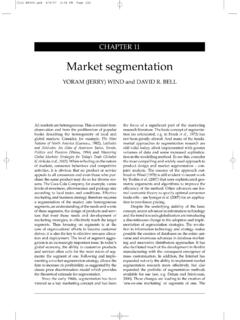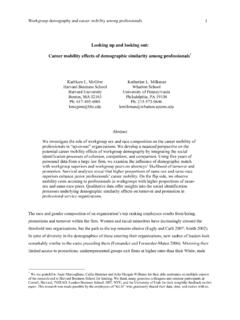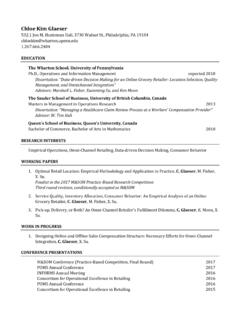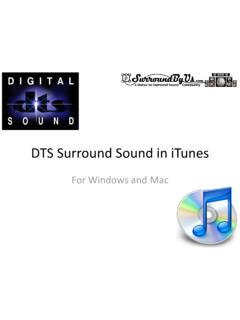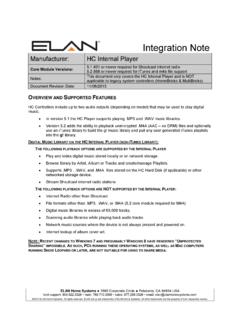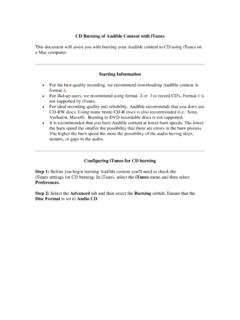Transcription of Music File Sharing and Sales Displacement in the iTunes Era
1 0 Music File Sharing and Sales Displacement in the iTunes Era Joel Waldfogel The Wharton School University of Pennsylvania June 15, 2009 Abstract A growing empirical literature examines the relationship between Music file Sharing and legal purchases of Music , but existing studies examine the period before consumers had attractive legal digital a la carte options. The iTunes Music Store has grown quickly since its appearance in 2003, and digital Music now accounts for a third of US recorded Music Sales . Using a new survey of University of Pennsylvania undergraduates, we ask how Music file Sharing and Sales Displacement operate in the iTunes era, when the alternative to file Sharing is purchasing individual songs, rather than entire albums.
2 We find large amounts of file Sharing in this population. Respondents have more stolen than paid Music , but the Music obtained via file Sharing is, for the most part, low-valuation Music which the respondents would likely not have purchased. The rate of Sales Displacement implied by the relationship between stolen and purchased Music across respondents is between and That is, an additional song stolen reduces paid consumption by between a third and a sixth of song. Perhaps surprisingly, this is about the same as the CD Sales Displacement rate found for the pre- iTunes era using a similar empirical approach on a similar study population. 1 A growing empirical literature examines the relationship between Music file Sharing and legal purchases of Music .
3 Most inquiries find large amounts of file Sharing activity and small rates of Displacement , generally less than a one-fourth reduction in Sales per stolen piece of Music . An important shortcoming of the existing empirical literature is its focus on the period before consumers had attractive legal digital options. Since Napster s appearance in 1999, digital distribution on the Internet made it possible for consumers to conveniently steal individual songs. Apart from some unsuccessful forays into digital distribution, the Music industry s best legal option was a physical CD. The US launch of the iTunes Music Store in 2003 gave consumers a new legal option, a single song available legally for $ The iTunes Music Store has grown quickly and dominates digital Sales .
4 As of 2008, digital Music accounted for 32 percent of recorded Music Sales in the US, three quarters of which were sold at the iTunes Music This paper asks whether the availability of a convenient and widely adopted outlet for purchasing a la carte digital songs has affected either the volume of unpaid consumption or the rate of Displacement of paid by unpaid consumption. In 2002 a consumer faced a choice between stealing, say, three songs and buying a 12-song CD that contained a few songs he or she wanted bundled with 9 more that he or she did not. Since 2003, consumers have faced a song-by-song choice between stealing and a la carte purchase for about $ Using a new survey of University of Pennsylvania undergraduates, we ask how Music file Sharing and Sales Displacement operate in the iTunes era.
5 1 See the RIAA s 2008 Yearend Shipments, at , accessed June 17, 2009. 2 After selling songs exclusively for $ , the iTunes Music introduced tiered pricing, at $ and $ , as well as $ , in 2009. Amazon sells songs at various prices, including $ and $ See , accessed June 17, 2009. 2 The paper proceeds in three sections following the introduction. Section 1 provides a simple theoretical framework, describes the historical background, from the appearance of Napster in 1999 to the appearance and growth of the iTunes Music Store since 2003, and makes reference to the existing empirical literature. Section 2 describes the survey data collected for this study, and section 3 presents results on Sales Displacement as well as the welfare effects of file Sharing .
6 A brief conclusion follows. We find large amounts of file Sharing in this population. Respondents have more stolen than paid Music . But the Music obtained via file Sharing is, for the most part, low-valuation Music which the respondents would likely not have purchased. The rate of Sales Displacement implied by the relationship between stolen and purchased Music across respondents is between and That is, an additional song stolen reduce paid consumption by between a third and a sixth of song. Perhaps surprisingly, this is roughly the same as the CD Sales Displacement rate found for the pre- iTunes era using a similar empirical approach for a similar study population. I. Background 1. Theory If Music has a positive price as it continues to, even with iTunes the Music market can be represented by a figure like Figure 1: A downwards-sloping demand curve, showing the distribution of valuations that consumers place on songs, along with a fixed positive price p.
7 Given this setup, the quantity sold is q. The area above the price and below the demand curve is 3 consumer surplus, pq is revenue, and the area below the demand curve to the right of q is deadweight loss. The question of whether file Sharing depresses Sales is the question of whether the songs obtained via file Sharing would otherwise have been purchased (along the demand curve with valuations above p). If they are the songs with valuations above the price, then file Sharing displaces Sales . If they are songs with valuations below the price and would otherwise not have been consumed then file Sharing does not displace Sales . In addition, if stolen songs would otherwise not have been purchased, then file Sharing raises consumer welfare without reducing industry revenue (see Rob and Waldfogel, 2006).
8 File Sharing may also shift the demand curve out and can, in principle, stimulate legal purchases, via a few different mechanisms. First, because Music is an experience good, it is possible that file Sharing allows consumers to sample which, in turn, informs them about what to purchase. That is, sampling may be an inducement to purchase. In addition to the possibility that file Sharing overcomes information problems, the sampling of a particular song may stimulate demand for other songs by the artist. Shapiro and Varian (1999) explore these and related arguments. Second, file Sharing can facilitate purchase by aggregating valuations for purchasing entities. If you and I are each willing to pay $ for a song priced at $1, neither of us will purchase it alone.
9 If we form a Music Sharing club, then inside the club, Music is a public good. The value of the song to the club is our collective willingness to pay, which exceeds the price, so the club buys the song where each of its members would not have (Bakos, Brynjolfsson, and Lichtman, 1999). Of course, Sharing can increase Sales via this mechanism only if Sharing 4 remains small-scale. If everyone can share songs with everyone else the club includes all consumers on earth - then while the club may be willing to buy many songs, the club may also be the only purchaser. The availability of free a la carte downloads may have changed some consumers willingness to pay for Music . Figure 2 depicts indifference curves and consumption opportunities for a consumer before and after Napster.
10 The lower indifference curve describes the consumer s willingness to pay for legal copies of recorded songs when piracy is not possible. The curve depicted passes through the money endowment (AOG,songs)=(100,0) and also passes below (85,12), so the consumer would be better off paying $15 to obtain the album than without the album. When illegal songs appear at a zero price, the consumer s willingness to pay for the closely related legal product is compromised. (Illegal songs are a substitute for legal songs, but not a perfect substitute. Hence the indifference curves for legal Music change). The new indifference curve passing through (100,0) passes above (85,12), so the consumer does not purchase the album. However, points associated with 1, 2, 3, and 4 songs lie above the new indifference curve, indicating that this consumer would be willing to pay for songs.
